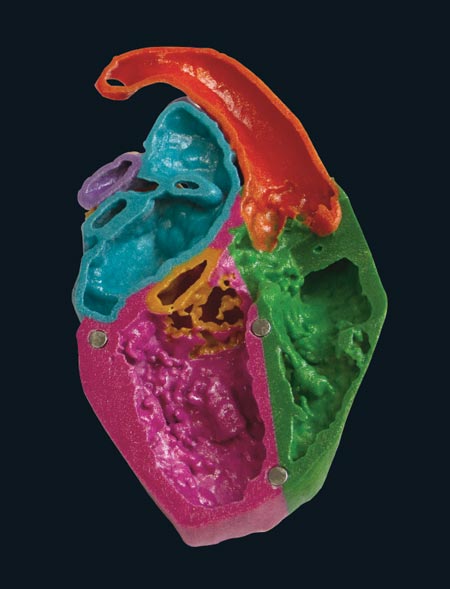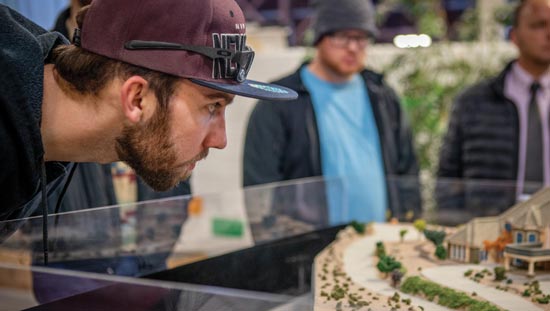All That is Fit to Print
Amy Renner Hendricks, contributing writer

Most people, when watching the Super Bowl, are cheering on their favorite team, cheating on diets with savory snacks, waiting for the half-time show, or just sticking around for the commercials, but, during Super Bowl 50 three years ago, Jerry Ropelato BS ’83 didn’t care if the Carolina Panthers or Denver Broncos won, was too worried to eat chips and salsa, didn’t hear the band Coldplay perform, and didn’t even laugh at the Doritos dogs advertisement (a national favorite). He just wanted — well, more like needed — the game to be over so he could breathe again.
You see, 33 hours earlier, Jerry’s 3D printing company, WhiteClouds, shipped a custom-made brace to Panthers’ linebacker Thomas Davis, who broke his arm during the NFC championship game two weeks before the Super Bowl. All Jerry could do while watching Davis play was hold his breath and say to himself, “Please don’t break on national TV, please don’t break on national TV.”
Fortunately for Jerry, and Davis, the brace held up perfectly, and while the Panthers lost by 14, it was a win for WhiteClouds. “That one project got so much press. Over 800 articles were written about it,” reports Jerry from his unassuming, but expansive, 43,000-square-foot workspace in the Business Depot Ogden industrial park, where he has a replica of Davis’ brace on display.
“Can you believe how big his arm was?” Jerry asks, picking up the device, which is almost as big as a football. “It’s unreal.” Other items are arranged around the brace. He grabs what looks like an animal bone. It’s solid, has a putty-type color and unique markings, but it’s really a 3D-printed orthopedic model, another WhiteClouds project.
“A dog had broken its leg and needed surgery,” Jerry explains. He points to a metal hinge fastened to the model. “This hinge needed to be bent a very specific way. Instead of doing that while the dog was under anesthesia, the vet was able to perfect the hinge and have it ready ahead of time, by first fitting it to this 3D model, which we printed from the dog’s CT scan.”
From the NFL to veterinarians, WhiteClouds has served a diverse, impressive group of clients since Jerry founded the company in 2013. Many of those clients rank toward the top of the Fortune 500, including Disney, Walmart and Target. For almost seven years, WhiteClouds has handled projects “from inception and design to full-color 3D printed product.”
Jerry is now in the middle of changing the business model — he’s always looking to innovate and improve. His latest plan is to use storytelling strategies to help WhiteClouds find niche clients, like companies looking for “selfie thrones” — think replicas of the Iron Throne from HBO fantasy Game of Thrones and NFL-branded thrones — to bring to tradeshows and other events.

“What’s really cool about this business is that you start with nothing, and then, layer by layer, you build really cool things,” Jerry says, as a whooshing sound interrupts him. He heads in the direction of the noise. On the way, he passes a 5-foot 3D model of Homer Simpson, and as he turns a corner, he sees a 20-foot-tall bag of the popular snack Boom Chicka Pop towering in the back. “It’s been a difficult industry to navigate, but it’s been really fun, too,” he says, as he eyes gigantic popcorn kernels spilling over the top of the bag. By the way, the noise he heard was an employee air-brushing a model dragon.
To Fail is to Learn
Jerry knows being an entrepreneur is risky. He has created eight businesses in his career, including the highly successful digital publishing company Purch, which had over 125 million unique web visitors each month. His first company wasn’t as prosperous. “I quit Weber State when I was a junior to start my own business … Rope Manufacturing. It was a miserable failure,” Jerry admits. “I was young and naive, and I didn’t have enough funds to make it work.”
The experience made him reflect on what he really wanted.
“I asked myself, ‘What classes did you enjoy at Weber State?’ The answer was business and computers, so I went back to Weber and majored in business processing. (Today that would be most like the management information systems major in the John B. Goddard School of Business & Economics.) That was one of the best decisions I’ve ever made. You have to learn to keep moving forward. To do that, you can’t be afraid of failure.”
Beyond Business
Jerry, the entrepreneur, is the guy kicking around ideas with employees and mulling over new business models. Jerry, the person, is the guy in the gym patiently coaching his grandkid’s kindergarten basketball team and whose favorite project isn’t the splashy Thomas Davis arm brace — although it brought a lot of attention to the company.
The project he values most is one that gave a little girl her life.
“Ella was born with her heart in the wrong place,” Jerry says, choking up. “It was a rare condition, and the surgeons weren’t quite sure how to fix it. We created a model of Ella’s heart from a CT scan, which doctors used to practice the surgery. About six months later, Ella’s parents brought her to our facility.”
While Jerry enjoys his work with big organizations like the NFL and Disney, he says moments like those with Ella and her parents make his work truly incredible.
“That was a fantastic day.”
The Future Right Here
Which industries benefit from 3D-printing technology? “All of them,” answers Jerry Ropelato BS ’83, CEO of Ogden-based 3D printing company WhiteClouds. “There isn’t a single sector that doesn’t, or couldn’t, benefit from the technology.”
With 3D printers being utilized in a broad base of industries, Weber State programs are giving students first-hand experience with the technology. More than 25 printers are in use at WSU, most of them partly funded by generous donors.
Here are six creative ways Wildcats are using 3D printers:
1. Manufacturing and systems engineering students use the printers to create custom parts, like rubber hoses.
2. Students in the John B. Goddard School of Business & Economics use the 3D printing lab in Wattis Business to create prototypes of products they’ve designed.
3. Physics professor John Sohl and his students print hardware housing for sensors that measure pollutant gases in the air.
4. Visual arts students create their final projects on 3D printers or use the printers to make “sketches” for larger, more-advanced sculptures.
5. The radiologic sciences department uses the technology to help students better visualize anatomical details.
6. When elementary education major Cora Arboleya can’t find what she needs to teach a concept for her course on teaching middle school math, she custom prints objects.
